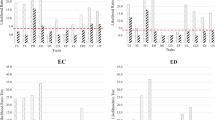Summary
Three-way cross means were predicted with formulae involving linear functions of general (GCA) and specific combining ability (SCA) effects estimated from single-cross factorials between genetically divergent populations. Data from an experiment with 66 single-cross and 66 three-way cross forage maize (Zea mays L.) hybrids was used for comparing the prediction formulae. The genotypic correlation (r) between observed and predicted three-way crosses increased with increasing χ, the weighting factor of SCA effects, for plant height and ear dry matter (DM) content. It displayed slightly convex curves for total and stover DM yield, ear percentage, and metabolizable energy content of stover. For Jenkins' method B, r was considerably less than 1.0 for all traits, indicating the presence of epistasis. The square root of heritability (hĜ) of the predicted means decreased with increasing χ, the reduction being small with a greater number of test environments. Using the product r·hĜ as a criterion of efficiency, none of the prediction methods was consistently superior and the differences among them were rather small (< 7.5%) for all traits, irrespective of the number of test environments. We recommend evaluating the GCA of a greater number of lines from each parent population in testcrosses with a small number of elite lines from the opposite population. All possible three-way or double crosses between both sets of lines should be predicted by Jenkins's method C. This procedure allows one to select with a higher intensity among the predicted hybrids and thus should increase the genetic gain.
Similar content being viewed by others
References
Cockerham CC (1967) Prediction of double crosses from single crosses. Züchter 37:160–169
Falconer DS (1981) Introduction to quantitative genetics. Longman Press, London New York
Geiger HH, Melchinger AE, Schmidt GA (1985) Analysis of factorial crosses between flint and dent maize inbred lines for forage performance and quality traits. Proc 13th Congr Maize and Sorghum Section of EUCARPIA. Pudoc Press, Wageningen, pp 147–154
Geiger HH, Melchinger AE, Seitz G, Schmidt GA (1986) Methods of predicting three-way crosses from single crosses between flint and dent inbred lines in forage maize (Zea mays L.). Proc 6th Meeting EUCARPIA Sect Biomet Plant Breed. Birmingham, pp 31–45
Hallauer AR, Miranda JB (1981) Quantitative genetics in maize breeding. Iowa State University Press, Ames, Iowa
Harville DA (1977) Maximum likelihood approaches to variance component estimation and to related problems. J Am Stat Assoc 72:320–338
Henderson CR (1963) Selection index and expected genetic advance. In: Statistical genetics and plant breeding. NAC-NRC Publ 982, pp 141–163
Henderson CR (1975) Best linear unbiased estimation and prediction under a selection model. Biometrics 31:423–447
Henderson CR (1977) Prediction of future records. Proc Int Conf Quantitative Genet. Iowa State University Press, Ames, Iowa
Kackar RN, Harville DA (1981) Unbiasedness of two-stage estimation and prediction procedures for mixed linear models. Commun Stat Theor Meth A 10:1249–1261
Jenkins MT (1934) Methods of estimating the performance of double crosses in corn. J Am Soc Agron 26:199–204
Melchinger AE (1984) Analysis of incomplete factorial mating designs. Proc 5th Meeting EUCARPIA Sect Biomet Plant Breed. Stuttgart-Hohenheim, pp 131–150
Mode CJ, Robinson HF (1959) Pleiotropism and the genetic variance and covariance. Biometrics 15:518–537
Otsuka Y, Eberhart SA, Russell WA (1972) Comparisons of prediction formulas for maize hybrids. Crop Sci 12:325–330
Schmidt GA (1986) Analyse faktorieller Kreuzungen zwischen Flint- und Dentinzuchtlinien bezüglich Leistungs- und Qualitätsmerkmalen bei Silomais. Dissertation Universität Hohenheim (FRG)
Wricke G, Weber WE (1986) Quantitative genetics and selection in plant breeding. Walter de Gruyter Press, Berlin New York, p 267
Author information
Authors and Affiliations
Additional information
Communicated by A. R. Hallauer
Extended version of a paper (Geiger et al. 1986) read at the sixth meeting of the EUCARPIA Section ‘Biometrics in Plant Breeding’ held at Birmingham, UK, July 28–August 1, 1986
Rights and permissions
About this article
Cite this article
Melchinger, A.E., Geiger, H.H., Seitz, G. et al. Optimum prediction of three-way crosses from single crosses in forage maize (Zea mays L.). Theoret. Appl. Genetics 74, 339–345 (1987). https://doi.org/10.1007/BF00274716
Received:
Accepted:
Issue Date:
DOI: https://doi.org/10.1007/BF00274716



